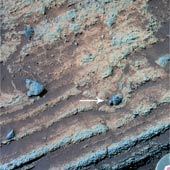A mysterious area of layered bedrock on Mars that has puzzled scientists was formed by a volcanic explosion, new research shows.

|
| ©Image Science
|
| A false-color image taken by the Mars rover Spirit shows a small rock "bomb" (indicated with arrow) and the impact "sag" it made in the Martian surface. The bomb is about 1.6 inches (4 centimeters) wide. Scientists say the rock may have been jettisoned by a volcanic eruption, leaving what one researcher called the first "powerful evidence of explosive materials" on Mars.
|
Spirit, one of NASA's two Mars rovers, mapped the tabletop-like formation, which scientists call Home Plate because of its shape resembling the home plate in baseball.
Analysis of the data collected by Spirit shows that the outcrop was probably formed by layers of ejected volcanic materials.
The larger grains of debris were buried under finer materials and later rearranged by wind, NASA scientists believe.
"It's the first really powerful evidence that either rover has found for explosive materials [on Mars]," said Steve Squyres, an astronomer at Cornell University and principal investigator of the rovers' mission.
His team's findings are reported in tomorrow's issue of the journal Science.
Volcanic Bomb
Located in Mars's Gusev crater, Home Plate stands a few yards high and 260 to 295 feet (80 to 90 meters) across.
(See a
map of Mars.)
Scientists had advanced several theories to explain how it formed, including the effects of wind and sand deposits.
But when Spirit began exploring the structure last fall, scientists noticed that Home Plate contained a "bomb sag," a depressed area on the ground where a rock, or "bomb," would have fallen.
"That provided compelling evidence that this was a case where there had been an explosion," Squyres said.
Further analysis suggested that such a rock likely originated from a volcanic eruption rather than from space.
"We find deposits that are compositionally basalt, which is kind of a volcanic rock, and very similar to other rocks in the vicinity that are clearly volcanic in origin," Squyres explained.
So far, however, scientists have not found a volcanic vent.
"What we have found is evidence suggesting that the material at Home Plate may actually be much more extensive than the Home Plate [itself] is," Squyres said.
That suggests the volcanic vent may be somewhere other than Home Plate.
"We suspect that much of the volcanic explosives have been eroded away and that Home Plate is a small erosional remnant of a formally more extensive deposit," he added.
"Basalt Goes Boom" But what would have caused the volcano to explode?
The presence of basalt may offer a clue.
"One way to get basalt to go boom is to have it come into contact with water," Squyres said.
"If there is water below the surface or near the surface and it suddenly comes into contact with very hot lava, it will flash into steam and you can get a steam-driven explosion.
"We speculate that the explosion here may have come about as a consequence of lava coming into contact with Martian groundwater," said Squyres.
Scientists believe that as much as half of Mars's surface may contain frozen water. (Read related story: "
Mars's Ice Patchy, Water Cycle Quite Active, Study Reveals" [May 2, 2007].)
Larry Crumpler is a curator of vulcanology and space sciences at the New Mexico Museum of Natural History and Science in Albuquerque and a member of the Mars rovers-science team.
Finding a volcanic vent, he said, may help scientists understand "the way volcanoes erupt, what the gases were when they erupted, and how the gases have been contributing to the atmosphere early in the history of Mars."
"That would be very exciting," he added.
Reader Comments
to our Newsletter